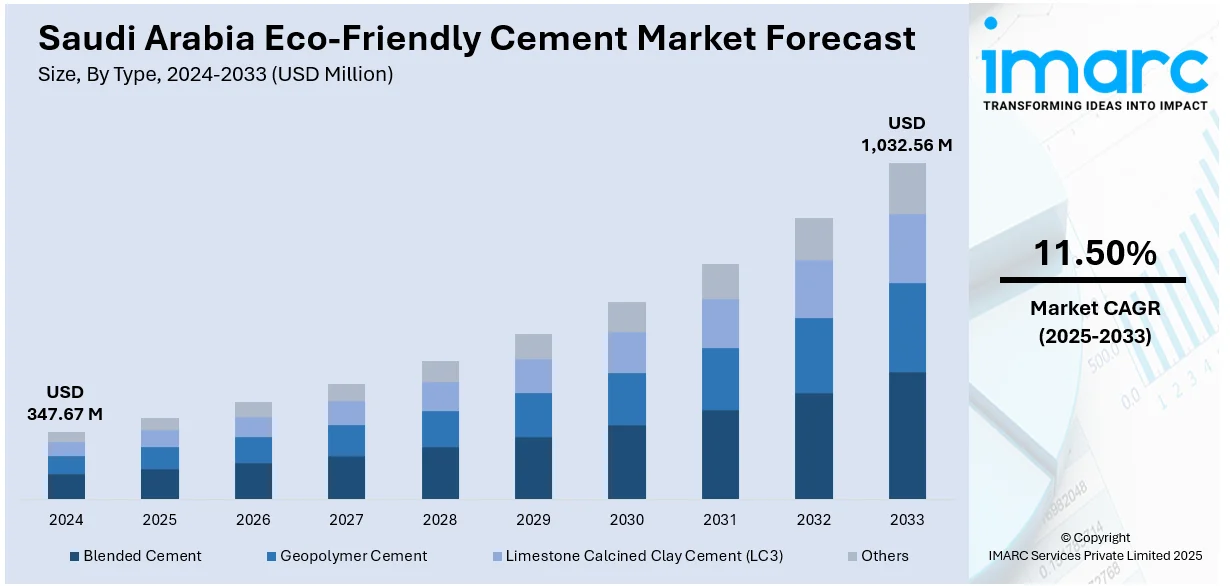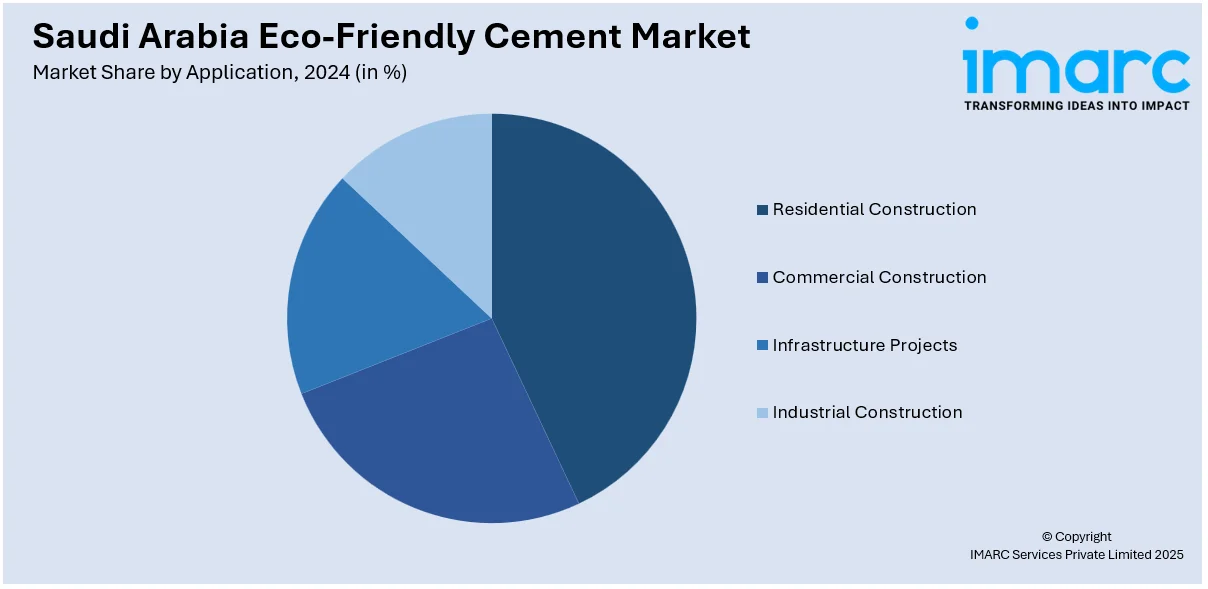
Saudi Arabia Eco-Friendly Cement Market Size, Share, Trends and Forecast by Type, Raw Material, Application, End User, and Region, 2025-2033
Saudi Arabia Eco-Friendly Cement Market Overview:
The Saudi Arabia eco-friendly cement market size reached USD 347.67 Million in 2024. Looking forward, IMARC Group expects the market to reach USD 1,032.56 Million by 2033, exhibiting a growth rate (CAGR) of 11.50% during 2025-2033. The growing demand for sustainable infrastructure and advancements in cement production technologies are supporting the market growth. Increased focus on green building initiatives and innovations in manufacturing, such as carbon capture and waste recycling, supports the shift toward sustainability and contributes to the expansion of the Saudi Arabia eco-friendly cement market share.
|
Report Attribute
|
Key Statistics
|
|---|---|
|
Base Year
|
2024 |
|
Forecast Years
|
2025-2033
|
|
Historical Years
|
2019-2024
|
| Market Size in 2024 | USD 347.67 Million |
| Market Forecast in 2033 | USD 1,032.56 Million |
| Market Growth Rate 2025-2033 | 11.50% |
Saudi Arabia Eco-Friendly Cement Market Trends:
Increasing Demand for Sustainable Infrastructure
The need for sustainable infrastructure in Saudi Arabia is increasing, fueled by an intensified emphasis on environmental sustainability. Both public and private sector efforts are progressively emphasizing the development of infrastructure that reduces environmental impact and maximizes resource efficiency. These initiatives are particularly noticeable in green construction projects, including sustainable city development and environment-friendly public structures, which are rapidly gaining momentum. Such initiatives include the adoption of low-carbon, sustainable materials, creating a significant market opportunity for eco-friendly cement. As the construction industry adapts to more sustainable methods, eco-friendly cement is emerging as an essential element in achieving the sustainability goals of these initiatives. This trend is anticipated to continue expanding as a component of Saudi Arabia’s larger initiative to develop smart cities and promote sustainable growth. For instance, in 2025, Construction Week revealed the initiation of the KSA Green Infrastructure Summit, scheduled to occur in Riyadh. The summit addressed subjects such as eco-friendly building materials, merging traditional architectural styles with environmentally conscious design, and exploring the financial obligations of different stakeholders. This event highlights Saudi Arabia’s continuous attempts to discover innovative solutions for climate change aligned with Vision 2030. The Saudi Arabia eco-friendly cement market growth is driven by its infrastructure projects and its environmental and sustainability goals, propelling the Kingdom towards a more sustainable future.

Technological Advancements in Cement Production
Recent advancements in manufacturing methods are allowing for the creation of cement that has a lower environmental impact while upholding or even improving its performance levels. Technologies like the adoption of alternative raw materials, waste recycling, and carbon capture systems are greatly reducing energy usage and carbon dioxide (CO2) emissions in the manufacturing process. These advancements enhance the competitiveness of eco-friendly cement regarding cost and quality, promoting its broader use throughout the industry. Furthermore, modern technologies are enabling the development of cement that is not only more resilient but also energy-conserving, satisfying the growing performance requirements of modern construction projects. With the advancement of these technologies, the market for eco-friendly cement is growing, providing significant environmental and financial advantages. A significant instance of these developments is a joint venture between Nizak Mining and Next Generation SCM from the UK, involving both British and Saudi entities. In 2024, they revealed intentions to construct the first low-carbon calcined clay supplementary cementitious material (SCM) factory in Riyadh, Saudi Arabia, employing Danish CemTower technology. Set to start production in Q3 2025, the facility aimed to cut cement-related CO2 emissions by as much as 99%, aligning with Saudi Arabia's Vision 2030 sustainability objectives. This initiative showcases the increasing drive for innovative, eco-friendly cement manufacturing within the Kingdom.
Saudi Arabia Eco-Friendly Cement Market Segmentation:
IMARC Group provides an analysis of the key trends in each segment of the market, along with forecasts at the country and regional levels for 2025-2033. Our report has categorized the market based on type, raw material, application, and end user.
Type Insights:
- Blended Cement
- Geopolymer Cement
- Limestone Calcined Clay Cement (LC3)
- Others
The report has provided a detailed breakup and analysis of the market based on the type. This includes blended cement, geopolymer cement, limestone calcined clay cement (LC3), and others.
Raw Material Insights:
- Fly Ash
- Slag
- Silica Fume
- Recycled Aggregates
- Others
A detailed breakup and analysis of the market based on the raw material have also been provided in the report. This includes fly ash, slag, silica fume, recycled aggregates, and others.
Application Insights:

- Residential Construction
- Commercial Construction
- Infrastructure Projects
- Industrial Construction
The report has provided a detailed breakup and analysis of the market based on the application. This includes residential construction, commercial construction, infrastructure projects, and industrial construction.
End User Insights:
- Government and Public Sector
- Private Contractors
- Individual Home Builders
A detailed breakup and analysis of the market based on the end user have also been provided in the report. This includes government and public sector, private contractors, and individual home builders.
Regional Insights:
- Northern and Central Region
- Western Region
- Eastern Region
- Southern Region
The report has also provided a comprehensive analysis of all the major regional markets, which include Northern and Central Region, Western Region, Eastern Region, and Southern Region.
Competitive Landscape:
The market research report has also provided a comprehensive analysis of the competitive landscape. Competitive analysis such as market structure, key player positioning, top winning strategies, competitive dashboard, and company evaluation quadrant has been covered in the report. Also, detailed profiles of all major companies have been provided.
Saudi Arabia Eco-Friendly Cement Market News:
- In January 2025, Al Jouf Cement Co announced its green cement will be used in NEOM projects, developed in partnership with Asas Al Muhailb Co. The product cuts CO₂ emissions by 30% and offers enhanced durability, sustainability, and resistance properties. This initiative aligns with Saudi Vision 2030 and promotes eco-friendly construction solutions.
- In January 2025, KAUST launched the Future Cement Initiative (FCI) to research low-carbon cement production and carbon capture methods. In collaboration with Saudi ministries and industry bodies, the project aims to cut emissions from limestone calcination. This supports Saudi Arabia’s carbon neutrality goal for 2060 and strengthens its eco-friendly industrial leadership.
Saudi Arabia Eco-Friendly Cement Market Report Coverage:
| Report Features | Details |
|---|---|
| Base Year of the Analysis | 2024 |
| Historical Period | 2019-2024 |
| Forecast Period | 2025-2033 |
| Units | Million USD |
| Scope of the Report |
Exploration of Historical Trends and Market Outlook, Industry Catalysts and Challenges, Segment-Wise Historical and Future Market Assessment:
|
| Types Covered | Blended Cement, Geopolymer Cement, Limestone Calcined Clay Cement (LC3), Others |
| Raw Materials Covered | Fly Ash, Slag, Silica Fume, Recycled Aggregates, Others |
| Applications Covered | Residential Construction, Commercial Construction, Infrastructure Projects, Industrial Construction |
| End Users Covered | Government and Public Sector, Private Contractors, Individual Home Builders |
| Regions Covered | Northern and Central Region, Western Region, Eastern Region, Southern Region |
| Customization Scope | 10% Free Customization |
| Post-Sale Analyst Support | 10-12 Weeks |
| Delivery Format | PDF and Excel through Email (We can also provide the editable version of the report in PPT/Word format on special request) |
Key Questions Answered in This Report:
- How has the Saudi Arabia eco-friendly cement market performed so far and how will it perform in the coming years?
- What is the breakup of the Saudi Arabia eco-friendly cement market on the basis of type?
- What is the breakup of the Saudi Arabia eco-friendly cement market on the basis of raw material?
- What is the breakup of the Saudi Arabia eco-friendly cement market on the basis of application?
- What is the breakup of the Saudi Arabia eco-friendly cement market on the basis of end user?
- What is the breakup of the Saudi Arabia eco-friendly cement market on the basis of region?
- What are the various stages in the value chain of the Saudi Arabia eco-friendly cement market?
- What are the key driving factors and challenges in the Saudi Arabia eco-friendly cement market?
- What is the structure of the Saudi Arabia eco-friendly cement market and who are the key players?
- What is the degree of competition in the Saudi Arabia eco-friendly cement market?
Key Benefits for Stakeholders:
- IMARC’s industry report offers a comprehensive quantitative analysis of various market segments, historical and current market trends, market forecasts, and dynamics of the Saudi Arabia eco-friendly cement market from 2019-2033.
- The research report provides the latest information on the market drivers, challenges, and opportunities in the Saudi Arabia eco-friendly cement market.
- Porter's five forces analysis assist stakeholders in assessing the impact of new entrants, competitive rivalry, supplier power, buyer power, and the threat of substitution. It helps stakeholders to analyze the level of competition within the Saudi Arabia eco-friendly cement industry and its attractiveness.
- Competitive landscape allows stakeholders to understand their competitive environment and provides an insight into the current positions of key players in the market.
Need more help?
- Speak to our experienced analysts for insights on the current market scenarios.
- Include additional segments and countries to customize the report as per your requirement.
- Gain an unparalleled competitive advantage in your domain by understanding how to utilize the report and positively impacting your operations and revenue.
- For further assistance, please connect with our analysts.
 Request Customization
Request Customization
 Speak to an Analyst
Speak to an Analyst
 Request Brochure
Request Brochure
 Inquire Before Buying
Inquire Before Buying




.webp)




.webp)












